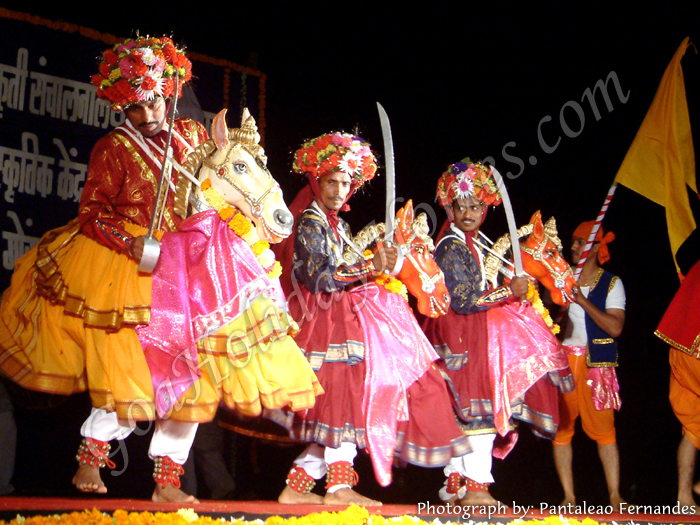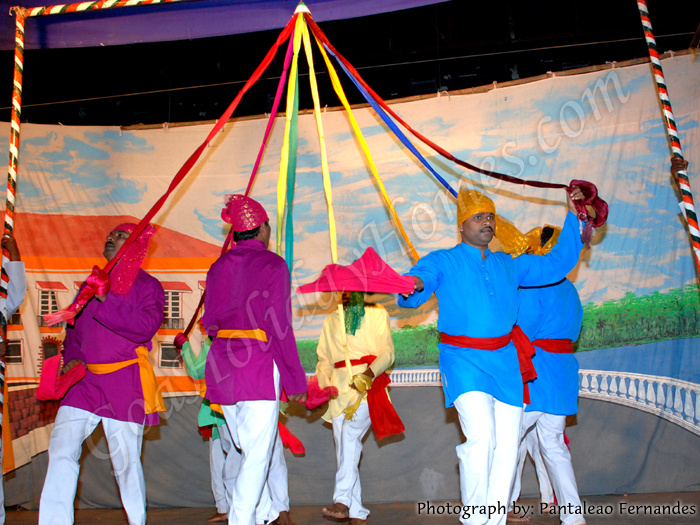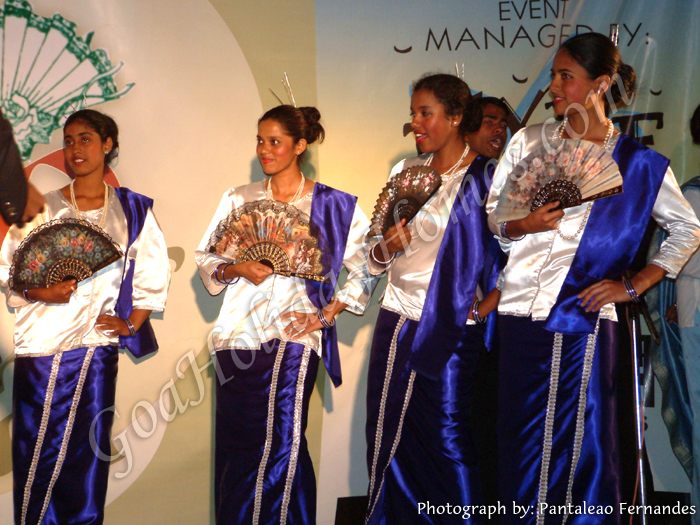Folk Songs & Dances in Goa
A total of 27 folk art forms have been identified in Goa by the Kala Academy at Panaji, which now promotes them by holding festivals and courses. The annual event that is the biggest for the folk art performers in Goa is the spring festival of peasants, Shigmostav, which is celebrated for a fortnight in March. Also known as 'The Hindu carnival', Shigmo, a 5 day festival of colors includes a procession of floats of various themes that is held in many towns. Some of the popular Goan folk dance forms and folk songs performed are:
Godhi Modni: A spectacular dance form performed in northern Goa during Shigmo is the horse dance Godhi Modni in which warriors with swords move forward and backward and mimic the movements of war horses with the martial sound of drums. They wear a decorated wooden effigy of a horse around the waist, a flowery headgear and in the anklets they carry ghungurs. It is believed that the dance commemorates the victory over the Portuguese by the Maratha rulers of the Sattari taluka in Goa known as the Ranes.
Rombat: On the second and third day of Shigmo another dance form called Rombat takes place in which men dancing to drums carry banners and umbrellas in a procession and wear traditional dresses. Also young boys signify the arrival of spring by waving green twigs.
Romat or Mell: Romat (called so in north Goa) or Mell (called so in central Goa) is the thanks-giving ceremonial dance cum procession march that is the most well known performance during Shigmo. Here the villagers march or dance to the nerve-racking beat of the drums, with huge banners, festooned sticks, ceremonial umbrellas and batons. It is colorful, noisy and crowded and ends at the headman's house or at the presiding deity's temple.
Some of the other dance forms performed during Shigmo are Talgadi, Goff, Tonyamell, and Morulem that are performed to soft music of a light drum and a harmonium and known for their rhythm, intricate foot work and body movements.
Talgadi: In Talgadi, dancers move around the village and perform in house courtyards. They dance to the beats of instruments like Zanj, Shamel and Ghumat wearing colorful costumes and flowers.
Goff: Goff performed in the Phalgun month during the Shigmo Festival is a popular dance in South Goa in which colorful cloth plaits hang from a point in the ceiling and dancers holding a plait each dance in such a way that a beautiful braid is formed. Then the whole braid is unraveled by reverse dance moves skillfully done by the dancers. The songs devoted to Lord Krishna are accompanied by folk instruments.
Tanyamell: Another dance called Tanyamell (Tone means a painted stick; Mell means a dancing group) that use costumes with a distinct touch of Kathiawar (a region of Gujarat) came to Goa with the early tribal settlers. It is also common to Gujarat along with Goff.
Morulem: Another Shigmostav dance known as Morulem has the dancers wearing peacock feathers on the head and a flowery garland around the neck. They move in mock resemblance to the peacock and invoke the deities by singing traditional songs.
Dekhni: Dekhni, a blend of Indian melody set to Western music is a very popular solo song - cum - dance performed by women. It is about a request and the resulting dialogue between a girl and the boatman as the girl wants to go across the river. She persuades him to take her there so that she can honor her commitment to sing in a wedding at the place of a man called 'Damu' and also offers her ornaments in return as she is in a hurry. The dancer usually carries a small clay oil lamp and performs to the folk drum called 'Ghumat'.
Foogdi: Goa's most popular song cum dance is Foogdi performed by women and that is performed on important social and religious occasions. It is an indoor dance that derives its name from the 'Foo Foo' sound made by the dancers by blowing air into a pot they hold as they spring rhythmically. No musical instruments are used. The most common version of Fugdi dance out of the 27 variations is the one performed in a circular pattern. Beginning at a slow pace of footwork with invocation to Hindu gods, it picks up speed towards the climax.
Dhalo: Dhalo is another weeklong popular dance cum song performed at a pre-selected venue called 'Mand' in someone's courtyard. Normally 24 women take part in this dance that is performed on moonlit winter nights when the paddy crop is near harvesting in the Hindu month of 'Pausha'. They form two parallel rows sing religious and social songs and putting their arms around each other's waist, move in unison. On the concluding day of the dance the women wear fancy dresses and caricature men folk of the village.
Mando: Mando is a group song set to Latin - American tune and popular with Goan Catholics that usually has boys and girls standing in two semicircular lines and singing in chorus. The girls wear a 'tollopo' that is a Burmese Sarong - type dress and the theme of the songs sung are mostly frustration and deception in love. Mando songs that are made up with the blend of Goan folk music and church music were first written in 1840. They are usually sung at wedding celebrations in honor of the bridal couple.
Virabhadra: Virabhadra a gift from the Kannada rulers of ancient Goa is a dance cum drama form performed at the end of Shigmostav created from the matted hair of the son of Lord Shankar. In this form the actor accompanied by two other actors dance with two swords in his hands and is supported by a group with musical shouts and dances.
Mussal: At the historical village of Chandor in the Kshatriya (warrior) caste villager's courtyard this Mussal (pounding mace) march - cum- dance is performed on the second day of Goan Carnival. The dance performed by men who carry 'Mussal' - a war weapon in medieval times, is performed with full Hindu martial even though the Kshatriyas of Chandor converted to Christianity long ago. The dance-cum-song is performed to celebrate the victory in the early 14th century of the Hindu King of Vijaynagar, Harihar, over the Cholas.
Kunbi dance: The Kunbi tribals who are the earliest settlers of Goa that have their home in the Cancona sub division perform this fast elegant Kunbi dance. The ancient folk traditions are retained even though they are converted to Christianity. Their dances are not religious and are uniquely social which belong to the pre Portuguese era. They usually wear simple traditional colorful dresses.
Kala and Dashavtar: These are folk art forms that represent the subsequent development of Jagar as theatre. Other popular folk drama forms include Ranmale, Ratkala and Tiatr.



